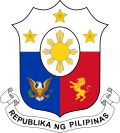
Back لغات في الفلبين Arabic Llingües de Filipines AST Mga tataramon kan Filipinas BCL Llengües de les Filipines Catalan Mga pinulongan sa Pilipinas CEB Sprachen der Philippinen German Lingvoj de la Filipinoj Esperanto Idiomas de Filipinas Spanish Filipiini keeled Estonian Filipinetako hizkuntzak Basque
| This article is part of a series on the |
| Culture of the Philippines |
|---|
 |
| Society |
| Arts and literature |
| Other |
| Symbols |
|
Philippines portal |
There are some 130 to 195 languages spoken in the Philippines, depending on the method of classification.[3][4][5][6] Almost all are Malayo-Polynesian languages native to the archipelago. A number of Spanish-influenced creole varieties generally called Chavacano along with some local varieties of Chinese[7][8][9] are also spoken in certain communities. The 1987 constitution designates Filipino, a de facto standardized version of Tagalog, as the national language and an official language along with English. Filipino is regulated by Commission on the Filipino Language and serves as a lingua franca used by Filipinos of various ethnolinguistic backgrounds.[10]
Republic Act 11106 declares Filipino Sign Language or FSL as the country's official sign language and as the Philippine government's official language in communicating with the Filipino Deaf.[11]
While Filipino is used for communication across the country's diverse linguistic groups and in popular culture, the government operates mostly using English. Including second-language speakers, there are more speakers of Filipino than English in the Philippines.[12] The other regional languages are given official auxiliary status in their respective places according to the constitution but particular languages are not specified.[13] Some of these regional languages are also used in education.[2]
The indigenous scripts of the Philippines (such as the Kulitan, Tagbanwa and others) are used very little; instead, Philippine languages are today written in the Latin script because of the Spanish and American colonial experience. Baybayin, though generally not understood, is one of the most well-known of the Philippine indigenous scripts and is used mainly in artistic applications such as on current Philippine banknotes, where the word "Pilipino" is inscribed using the writing system. Additionally, the Arabic script is used in the Muslim areas in the southern Philippines.
Tagalog and Cebuano are the most commonly spoken native languages. Filipino and English are the official languages of the Philippines. The official languages were used as the main modes of instruction in schools, allowing mother tongues as auxiliary languages of instruction.[14] The Philippine Department of Education (DepEd) has put forth initiatives in using mother tongues as modes of instructions over the years.[15][16][17]
- ^ Constitution of the Republic of the Philippines, Article XIV, Section 7
- ^ a b "DepEd adds 7 languages to mother tongue-based education for Kinder to Grade 3". GMA News Online. July 13, 2013. Retrieved August 6, 2018.
- ^ "Philippines". Ethnologue. Retrieved September 28, 2017.
- ^ McFarland, C.D. (1994). "Subgrouping and Number of Philippine Languages". Philippine Journal of Linguistics. 25 (1–2): 75–84. ISSN 0048-3796.
- ^ The Komisyon sa Wikang Filipino enumerated 134 Philippine languages and 1 national language (Filipino) present in the country through its Atlas Filipinas map published in 2016.
- ^ "What languages are spoken in the Philippines?". www.futurelearn.com. Future Learn. July 11, 2022.
- ^ Tsai, Hui-Ming 蔡惠名 (2017). Fēilǜbīn zán rén huà (Lán-lâng-uē) yánjiū 菲律賓咱人話(Lán-lâng-uē)研究 [A Study of Philippine Hokkien Language] (PhD thesis) (in Chinese). National Taiwan Normal University.
- ^ Wong Gonzales, Wilkinson Daniel (May 2016). "Exploring trilingual code-switching: The case of 'Hokaglish' (PDF Download Available)". Retrieved October 24, 2016 – via ResearchGate.
- ^ Palanca, Ellen H. (2002). "A Comparative Study of Chinese Education in the Philippines and Malaysia*" (PDF). Asian Studies. 38 (2): 1 – via Asian Studies: Journal of Critical Perspectives on Asia.
- ^ Filipino, not English, is the country’s lingua franca, Inquirer, Feb 27, 2014
- ^ "[Republic Act No. 11106] An Act Declaring the Filipino Sign Language as the National Sign Language of the Filipino Deaf and the Official Sign Language of Government in All Transactions Involving the Deaf, and Mandating Its Use in Schools, Broadcast Media, and Workplaces" (PDF). Official Gazette. Government of the Philippines. October 30, 2018.
- ^ Eberhard, David M.; Gary F. Simons; Charles D. Fennig, eds. (2021). "Philippines". Ethnologue: Languages of the World (Twenty-fourth ed.). Dallas, Texas: SIL International.
- ^ The regional languages are the auxiliary official languages in the regions and shall serve as auxiliary media of instruction therein... Article XIV Section 7.
- ^ "DepEd Order No. 60, 2008" (PDF). Republic of the Philippines. August 27, 2008.
- ^ "DepEd Order No. 74, 2009" (PDF). Republic of the Philippines. July 14, 2009.
- ^ "DepEd Curriculum Guide 2013" (PDF). Republic of the Philippines.
- ^ "DepEd open to more dialogue on improvement of MTB-MLE implementation". DepEd.
© MMXXIII Rich X Search. We shall prevail. All rights reserved. Rich X Search

